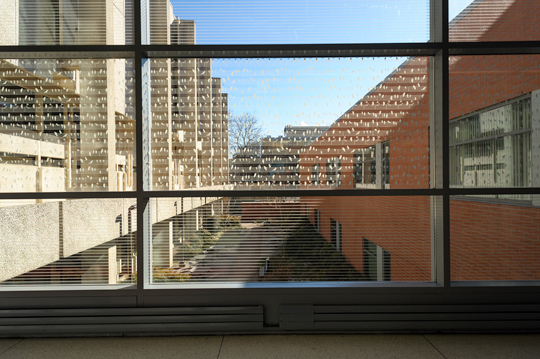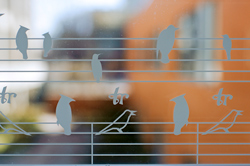 Temple University students walk past windows decked out with bird-saving decals designed by Molly Denisevicz. Photos by Christian HunoldA four-inch smudge marked the spot where, last fall, a zipping bird smacked into a window on Temple University’s campus. Today, birds flying toward the same window in the corridor connecting the Paley Library and the Tuttleman Learning Center will see silhouettes of feathered friends perched on a musical staff—a student-designed, research-based pattern that warns them of the solid obstacle in their path.
Temple University students walk past windows decked out with bird-saving decals designed by Molly Denisevicz. Photos by Christian HunoldA four-inch smudge marked the spot where, last fall, a zipping bird smacked into a window on Temple University’s campus. Today, birds flying toward the same window in the corridor connecting the Paley Library and the Tuttleman Learning Center will see silhouettes of feathered friends perched on a musical staff—a student-designed, research-based pattern that warns them of the solid obstacle in their path.A four-inch smudge marked the spot where, last fall, a zipping bird smacked into a window on Temple University’s campus. Today, birds flying toward the same window in the corridor connecting the Paley Library and the Tuttleman Learning Center will see silhouettes of feathered friends perched on a musical staff—a student-designed, research-based pattern that warns them of the solid obstacle in their path.
“When I would walk home, I would see birds on power lines, and I thought about how they look a lot like notes on a staff,” says Molly Denisevicz, a senior in Temple’s Tyler School of Arts’ Fibers and Material Studies program. Denisevicz submitted her film design as part of a sophomore design class and beat out more than 90 entries in a juried competition. Now birds on Temple’s campus will see Molly’s design and pull up before it is too late.
Birds fly into glass because they want to reach what they see through it or reflected in it—trees on which they would like to land, for example. This often makes buildings that house otherwise bird-friendly institutions particularly deadly.
“Visitor centers [in parks] covered in glass are particular offenders” because the glass reflects the surrounding natural habitat, says Daniel Klem, ornithologist of Muhlenburg College in Allentown, Pa. Klem adds that the same is often true for buildings at colleges and universities, whose windows can reflect the greenery of landscaped campuses.
“It really is disconcerting to see the dead birds. [It’s] upsetting to students, to faculty,” says Kathleen Grady, Director of Sustainability at Temple University. The Temple grounds staff was the first to notice patterns of dead birds on campus, spurring a campus response.
“For the past five years, [Temple’s] Office of Sustainability has been supporting research on bird strikes to analyze the problem, then research on different interventions,” Grady says. They tried posting life-size hawk models near popular windows to scare off collision-prone songbirds, but they kept dying. Students had better results sticking bird-shaped cutouts onto the dark, reflective ground-floor windows of Beury Hall, effectively warning the real birds away.
Netting strung in front of windows also works, as Grady has demonstrated on a glass corridor connecting two sections of Beury Hall. The birds bounce off safely and live to fly another day. “The netting can be installed just during migrations,” Grady says. Indeed it’s an advantage for those looking to preserve a clear view of the outside the rest of the year.
Migrating birds fare the worst, says Keith Russell, Philadelphia Outreach Coordinator for the National Audubon Society. Audubon conducted a study of bird collisions in collaboration with the Academy of Natural Sciences and the Philadelphia Zoo from 2008 to 2011. The study focused on a three-and-a-half block area in Center City and counted up to 190 migratory casualties per migration. “Within that area, we found dead or injured individuals of 55 species over the three years,” Russell says. The traveling birds, which spend most of their lives in wilder settings, stop for a rest and food only to encounter glass for the first (and last) time.
Only a few birds might die on a particular window, but there are a lot of windows in the U.S. These kill about 600 million birds per year, according to a 2014 study by researchers at the U.S. Fish and Wildlife Service and the Smithsonian’s Migratory Bird Center, which would “place buildings behind only free-ranging domestic cats among sources of direct human-caused mortality of birds,” according to the authors.
 Urban birds quickly learn how glass works, or they die trying, as the Moore College of Art & Design discovered last summer. The neighboring Franklin Institute hosts a breeding pair of red-tailed hawks (viewable online via a live videostream of the nest). Two of this year’s fledglings perished after crashing into windows at Moore.
Urban birds quickly learn how glass works, or they die trying, as the Moore College of Art & Design discovered last summer. The neighboring Franklin Institute hosts a breeding pair of red-tailed hawks (viewable online via a live videostream of the nest). Two of this year’s fledglings perished after crashing into windows at Moore.
“The problem is that they’re urban birds of prey, and there are a lot of windows around,” says Moore President Cecelia Fitzgibbon. “A confluence of circumstances allowed us to respond quickly,” she adds. “There had been discussion of placing scrim artwork by students already.” It was a simple matter to hang the gauzy fabric works across the windows, signaling to birds that the windows are solid.
Muhlenburg’s Klem, who has spent his career researching bird collisions and its solutions, found that simple patterns of lines (which could be stuck on the windows, although even cords hung in front would suffice) are enough to steer them away. He also has looked into using patterns that are invisible to humans because many birds can detect ultraviolet light. A German company, Ornilux, has integrated ultraviolet patterns into manufactured window glass, though Klem found their products to be ineffective. “The signal character has to be stronger,” Klem says. In the meantime, simple, opaque patterns can do the trick.
New York company SurfaceCare has been making windows visible to birds since a 2007 project on a Manhattan post office. “It’s not exactly magic; it’s just common sense,” says Marc Sklar, SurfaceCare’s owner. Student and faculty researchers pinpointed glass corridors connecting buildings as bird death traps, according to Grady. Birds flying between buildings don’t realize the windows in their path are solid until it’s too late. The design on the corridor between Temple’s Paley Library and the Tuttleman Learning Center ended up on the window as a film installed by SurfaceCare, working with Glass Care in New Jersey.
You don’t need a work of art to save the birds, but Temple University officials wanted to get the word out about a simple solution to bird collisions. As Tyler Professor Alice E. Drueding says, “It’s critical to contribute to social discourse formation and communicate a message that needs to get out there.”
Bernard Brown is an amateur field herper and bureaucrat. He writes about urban natural history and sustainable eating.



